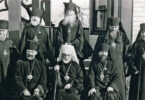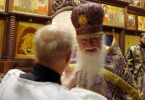Abbess Ekaterina (Efimovskaia) passed away on this day in 1925.
Mother Ekaterina belonged to the number of Russian aristocrats who, having decided to leave the world, founded monasteries of their own. She was born in 1850, as Countess Evgeniia Borisovna Efimovskaia. Many of her educated contemporaries were sensitive to the social injustices of class society. However, she responded differently to these challenges than most of them. Evgeniia Borisovna initially taught in various elementary schools in Russia and Ukraine. Eventually, St. Ambrose of Optina blessed her to found a convent.
To this end, Archbishop Leontii (Lebedinskii) of Warsaw and Holm offered her a deserted Roman Catholic convent near Lesna. In 1885, Countess Efimovskaia arrived there with five novices and two orphans. In 1889, the community was elevated to the rank of a convent, and soon after, Evgeniia Borisovna was tonsured a nun and installed as an abbess. She did not shy away from doing the same work as a novice would do, singing and chanting in church.
Similarly to the Grand Duchess and Abbess Elisabeth, Ekaterina sought ways for the monastery to participate in social ministry. Responding to this need, the Russian canonist Sergei V. Troitskii published in 1912 the study Deaconesses in the Orthodox Church. St. John of Kronstadt supported the convent. In 1900, Emperor Nicholas II decorated the abbess with a jeweled cross.
In 1915, the convent was evacuated to Petrograd. Then, responding to the invitation of Archbishop Anastasii of Kishinev and Hotin, the sisters moved to Moldova. In December 1917, the newly founded Moldavian parliament, the Sfatul Țării, proclaimed Bessarabia a democratic republic in federation with Russia. Then, the Sfatul Țării, by a majority of votes, approved an invitation for Romanian troops to enter Moldova. In February 1918, the Sfatul Țării pronounced the independence of the Moldavian Republic. Archbishop Anastasii, in a speech given in his cathedral on that day, mentioned his patriotic feelings for this new sovereign state and spoke positively about the necessity of developing cooperation with Romania.
In April 1918, the Chairman of the Synod of the Romanian Church, Metropolitan Pimen Georgescu, sent a telegram to Archbishop Anastasii inviting him to join the Synod of the Romanian Church. The Archbishop responded that he could not decide without consulting the Russian Church. As a result, he was banned from the country. The authorities began to pressure the Lesna Convent to assume Romanian citizenship and to conduct services in Romanian. In 1920, the convent moved to the newly founded Kingdom of Serbs, Croats, and Slovenians. The sisters opened an orphanage in the ancient monastery Hopovo, on Fruška Gora, which looked after 500 children. Naturally, the convent became a place for youth gatherings, like the one I was writing about on September 4, organized by the YMCA. It took place a little over one month before Abbess Ekaterina departed this life.
Sources:
Dmitry P. Anashkin, “Ekaterina,” Pravoslavnaia Entsiklopedia.
“Lesninskii Bogoroditskii Zhenskii Monastyr’ [Lesna Convent of the Mother of God], Pravoslavnaia Entsiklopedia.











